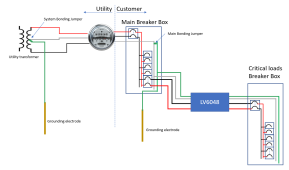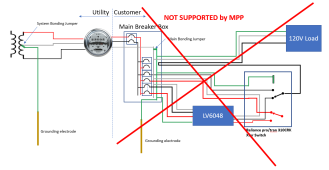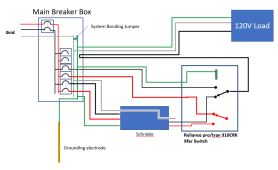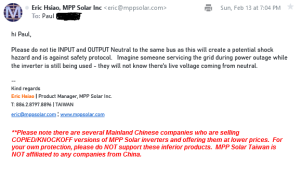FilterGuy
Solar Engineering Consultant - EG4 and Consumers
The conversation has gotten confusing and it is not clear who is referring to what diagram.It may not be a NEC requirement, however you missed one important point. If the N-G bond occurs in the main panel and the inverter is powering the loads, the N-G bond will be a ground fault and trip the breaker on the inverter as it is the source, not the main panel.
This is why the neutrals should be in the subpanel after the inverter and not in the main panel.
I go back to my previous rules and notes:
1) If the AC power source (The inverter) has a Neutral-Ground bond, it is a separately derived source and a transfer switch between it and a utility must switch neutral.
[In this case, leaving the neutrals on the main panel would be a problem]
2) If the AC power source does not have a Neutral-Ground bond, it is NOT a separately derived source and a transfer switch between it and a utility must NOT switch neutral.
[In this case, leaving the neutrals on the main panel would *not* be a problem. However, see the note below about the complication of having the grid power as an input on the transfer switch and on the input of the inverter/charger.
Note 1) Where things get complicated is when the utility is on the input of the inverter, there is no N-G bond created in the inverter, and there is a transfer switch that selects between the inverter output and the utility. Since there is no N-G bond the rule would say that you should not switch neutral, but that ends up with the inverter input-neutral tied to the inverter output neutral.....and the documentation for a lot of the lower end inverters does not say whether this is acceptable or not. Inverters that generate an N-G bond when in invert mode are intended to have separate neutrals, but some of them can operate with a common neutral.
Note 2) MPP provided a way to disable it's internal bonding relay, but I have not seen anything from them that says tieing the input and output neutrals together is acceptable. I sent MPP a question about common neutral but have not heard back from them (See post 54). I pinged them again yesterday but I do not know if I will ever hear back. (Part of the delay may be due to Chinese new-year)
Note 3) On at least the older versions of the 3K Growatts, Growatt has said hooking the input neutral and output neutral together is the proper way to do it. (In this case, leaving the neutrals in the main breaker panel would work). The newer 3K growatts have an internal bonding relay and I do not know if there is a supported way of disabling the relay. Assuming there is a way to disable the relay, I also do not know if growatt would support connecting the input and output neutrals on the newer 3K units.
Note 4) On the Schnider and Solark inverters, the input and output neutrals are tied together internally. In this case leaving the neutrals on the main panel would work fine.










